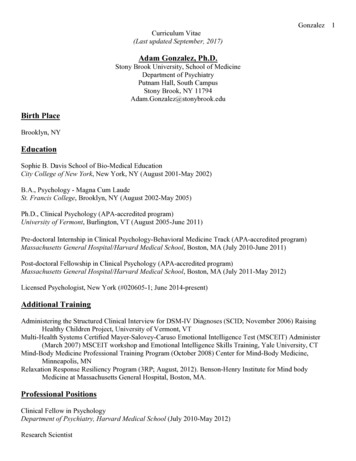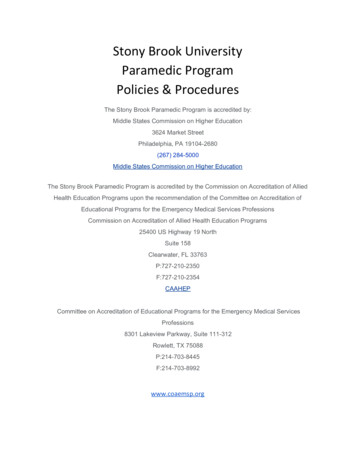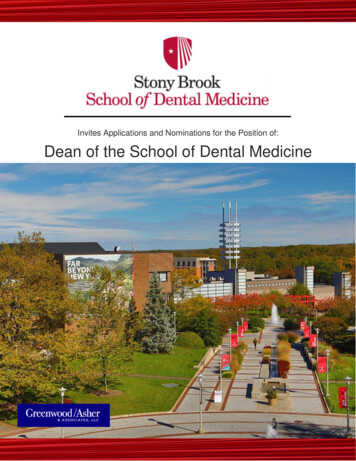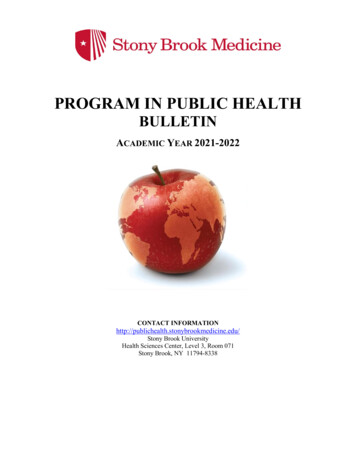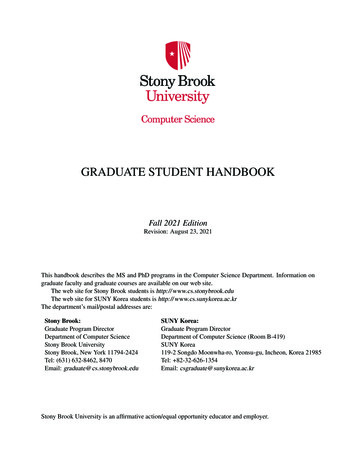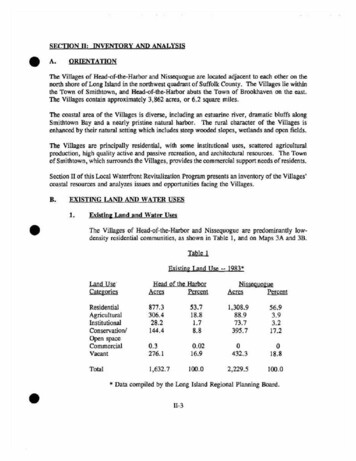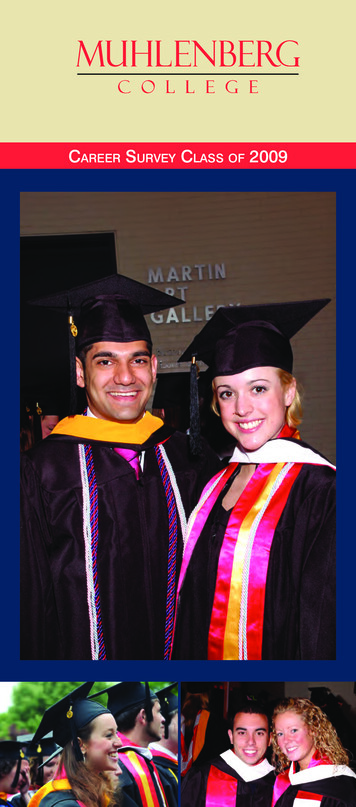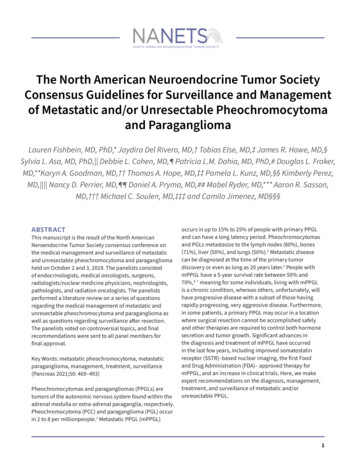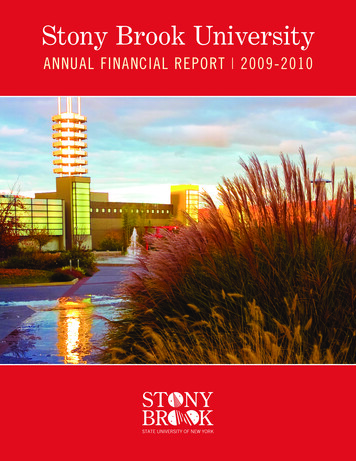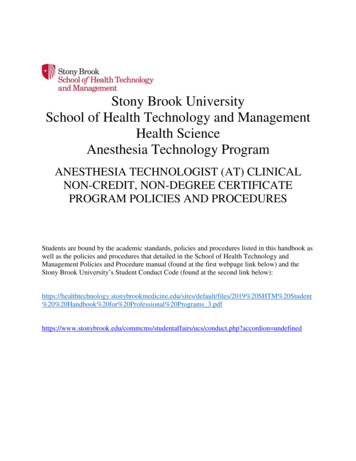
Transcription
Stony Brook UniversitySchool of Health Technology and ManagementHealth ScienceAnesthesia Technology ProgramANESTHESIA TECHNOLOGIST (AT) CLINICALNON-CREDIT, NON-DEGREE CERTIFICATEPROGRAM POLICIES AND PROCEDURESStudents are bound by the academic standards, policies and procedures listed in this handbook aswell as the policies and procedures that detailed in the School of Health Technology andManagement Policies and Procedure manual (found at the first webpage link below) and theStony Brook University’s Student Conduct Code (found at the second link 20Handbook%20for%20Professional%20Programs airs/ucs/conduct.php?accordion undefined
Anesthesia Technology Program: Mission Statement and Student LearningOutcomesThe anesthesia technology program is two years in length. The first year of the anesthesiatechnology program (the Health Science senior year) is designed to provide the didacticfoundation required for the ASATT national certification. The second years is a continuation ofstudy in a clinical non-credit, non-degree certificate program which is designed to foster clinicalcompetency at the level of an anesthesia technologist. Successful completion of both years is aneligibility requirement to qualify for the ASATT national certification examination.The overarching vision of the Health Science major is to provide the highest qualityundergraduate education that integrates the principles of scholarship, ethics, culturalcompetency, communication skills, critical thinking, evidence-based practice, and civicorientation to meet the diverse regional needs of the evolving health care industry.Anesthesia Technology (AT) Program Mission Statement: The mission of the AT program isto develop the knowledge, attitudes, skills and competencies required to function as an integralmember of an anesthesia team in diverse surgical settings. Through didactic lessons and clinicalwork students will hone their skills that are required to provide the highest quality patient carewhile maintaining the ethical standards and professionalism required in this dynamic profession.Goal 1: Students will demonstrate clinical competence of an entry-level anesthesia technologist.Student Learning Outcomes: Students will demonstrate basic knowledge relative to the surgical proceduresconducted in each surgical service. Students will demonstrate technologist level skills relative to the surgical proceduresconducted in each surgical service.Goal 2: Students will possess critical thinking skillsStudent Learning Outcomes: Students will adequately respond to challenges faced during a surgical procedure. Students will show the ability to perform multiple tasks in a timely manner.Goal 3: Students will practice with professional valuesStudent Learning Outcomes: Students will display professional conduct Students demonstrate life-long learningGoal 4: Students will display effective communication skillsStudent Learning Outcomes: Students will demonstrate written communication skills Students will demonstrate oral communication skills
General Information1) The Anesthesia Technologist Clinical Program is considered to be a full-time programa. Sign in: 0600-0615 & Sign out: 1400-1415, 5 days a week.b. Students (AT Interns) are expected to complete the program within one academicyear. The program consists of clinical rotations in the operating rooms, obstetricsuite and other clinical locations at Stony Brook University Medical Center aswell as didactic (classroom) teaching sessions. The AT Intern will be expected toparticipate fully and actively in the clinical rotations and teaching sessions.2) As per the School of Health Technology and Management, students participating inclinical programs must provide evidence of health insurance.3) NO STUDENT WILL BE PERMITTED TO ENTER THE CLINICAL SETTINGWITHOUT MEDICAL CLEARANCE FROM STUDENT HEALTH SERVICES.4) Students will not be permitted to enter the clinical setting without proper identification(e.g. student identification badge). Badges will not be issued to students if there is a hold(e.g. outstanding balance, lack of medical clearance, etc.) on their account.5) Students must abide by University Hospital policies and procedures including but notlimited to accessing clinical areas, use of equipment and medical records, infectioncontrol, influenza vaccinations (or other approved procedures for infection control), etc.More detail will be provided by your program director and clinical faculty.Tuition and Refund Policy1) Tuition will be charged at the rate of 5,000.00 for the clinical non-credit, non-degreecertificate program plus university fees. See the following link for a list of requireduniversity tion/certificate-program2) This tuition must be paid in full one week prior to the start of the program. Students willnot be permitted to attend classes or clinical education beyond the posted tuition deadlinedate.3) Students who withdraw from the Anesthesia Technology Program are liable for paymentof tuition in accordance with the following schedule:WithdrawalFirst WeekSecond WeekThird WeekLiability0%30%50%
Fourth Week70%Fifth Week100%4) Orientation will be held on the first day of the program. Absence from classes does notconstitute an official withdrawal and does not relieve the student of his or her financialobligation or entitle the student to a refund. Students must officially request to withdraw,in writing, to the Dean’s office.5) Students will be responsible for other fees incurred during the duration of the program.Such fees include, but are not limited to, background checks or drug testing required byclinical affiliates, books, malpractice insurance, hospital parking fees, etc.Performance Skills and Attitudes – Assessment ProceduresIn addition to mastery of cognitive skills and knowledge, students will be evaluated on theirperformance skills and attitudes. These include: Adherence to the University Code of Conduct and University Hospital policies andprocedures Ability to work with and relate to peers, patients, faculty and other members of the healthcare team Attitude Attendance and punctuality Appearance and professional demeanorIn addition to the General Rules of Conduct:Only designated faculty (such as the Attending Anesthesiologist assigned to the case orthe AT Interns Preceptor) can document and/ or authorize time and sign your request tobe released from clinical responsibilities. In the Ambulatory Surgical Center, only theAttending Anesthesiologist present at 1430 can document and/or authorize time and signyour request to be released from clinical responsibilities. It should be within the AT Committee’s discretion to determine if an intern has earnedthe credit for that day based on their clinical performance, productivity andprofessionalism. After set-ups interns should meet with the anesthesia team to discuss their cases. This isto communicate and learn more about the cases. No hanging in the hallways between case set-ups and start-ups, in the name of “waiting”.
No such thing as “my rooms are done for the day”. In days wherein the case schedule inthe assigned room/s is completed or cancelled prior 1400-1415, the student (AT intern) isrequired to communicate immediately with the clinical faculty (AT preceptor or Drs.Lagade) to be reassigned to other room/s. Anticipate and judge the beginning/finish of the cases before taking breaks or leavingrooms. Interns should remain in the assigned clinical area for the entire 8 hours. During off siterotations, an intern should report to the main OR whenever case schedule is not inprogress or cancelled.L & D rotation (0700-1200), an intern should report at 1230 to the main OR after lunch(1200-1230).ASC rotation, an intern should report to ASC on MTRF. On Wednesdays, attendance tomorning teaching sessions, then an intern should report toEndoscopy Suite. Cell phones should not be visible while in the OR.o Cellphones must be set on vibrate.o Only acceptable use of a cell phone in clinical setting is to communicate with ATintern preceptor (i.e. receive messages from program director and faculty).o Students using cellphones for other purposes during the clinical hours will besubject to probation/termination. No hanging out, sitting inside or passing by the Anesthesia work room without relatedpurposes. Interns should not be permitted to use the computer inside the Anesthesia work room oranywhere in the OR. Instead, use it in the library after clinical hours.Successful completion of each sub-specialty rotation requires that the student continuouslymaintain high standards. This means that regardless of one’s level of achievement in cognitiveskills and knowledge, if one’s professional behavior is not appropriate, he/she may not meetminimum requirements for successful completion of the sub-specialty rotation.
Unsatisfactory Performance Skills or AttitudesUnsatisfactory behavior, such as disruption of class activities during seminars and workshops,expression of derogatory, disrespectful remarks to the clinical staff, faculty, peers, or patients,inability to work with peers, or excessive unexcused absences (full or partial days and returninglate from breaks) may be cause for warning or further action.A student who has exhibited unsatisfactory behavior that may affect his or her final evaluationand academic standing shall receive a warning from the clinical faculty that stated behavior mayjeopardize successful completion and lead to failure of the sub-specialty rotation. If the studentdoes not amend behavior subsequent to verbal warning they will be placed on probation. Clinical staff include the Attending Physicians, Residents, Nurses, Nurse Anesthetist,CRNA educator, Anesthesia technologists and technicians, and OR staff. Clinical faculty include: Drs. Lagade, Vitkun, and the AT Student Intern Preceptors(Shoba Sanu, CRNA and Melissa Day, CRNA). The clinical faculty also includes theChair of the department, Dr. Deborah Zelizer.General Rules of Conduct and SafetyStudents are expected to conduct themselves in a professional manner, adhere to all hospitalpolicy and procedure safety guidelines at all times.OR Attire in all semi restricted (OR/Procedure Hallways) and restricted (ORs/Procedurerooms) areasAny student not complying with the policy below will be removed from the procedural area, andtermination from the program.In accordance with our existing policy: OR Attire in all semi restricted (OR/Procedure Hallways) and restricted (OR’s/Procedurerooms) areas Only hospital issued and hospital laundered scrubs may be worn in OR/Procedure roomsand must be changed daily. All Head & Facial Hair must be covered – NO EXCEPTIONS. Knight hoods and masksrequired for facial hair. All head and neck jewelry except stud earrings must be removed – NO EXCEPTIONSo Stud earrings may remain only if they are covered at all times
No Cover Jackets from outside the operating/procedure rooms may be worn No personal belongings including but not limited to purses/backpacks/computer bags areto be taken into the OR/procedural restricted and semi restricted areas. When leaving a procedural suite scrubs must be covered by a buttoned lab coat or closedsingle use gown. No lanyards may be worn Only hospital supplied disposable head coverings may be worn.Leadership surveillance will be conducted during all shifts to ensure compliance with thisimmediate corrective action. This surveillance begins at the point of the semi-restricted area.This surveillance will also include roaming observations.Conduct: Students will address the staff, faculty, patients, and fellow students by their appropriatetitle and/or last name. Sign in time is from 0600-0615 and Sign out time is 1400-1415. Students will documenttheir time using the punch machine.o Punching in or out for someone is considered an incident of academic dishonesty.o Students must be in scrubs ready to work by 0615. [Note: students are notpermitted to wear scrubs home and must obtain a clean pair of scrubs eachmorning from the scrub machine before entering the clinical setting].o Students are not to leave their clinical duties until 1400.o If a student signs in at any time other than the designated time, without priorapproval, student will under no circumstances be given credit for that day. Students may not work through lunch breaks in order to leave clinic early. Only designated faculty (such as the AT Student Intern Preceptor) can document and/orauthorize your request to be released from your clinical responsibilities. In the absenceof the AT Student Intern Preceptors: Shoba Sanu, CRNA and Melissa Day, CRNAstudents must contact Drs. Lagade, or Vitkun. Students cannot work at their assigned unit for more than eight (8) hours in any singleday. Signing in or out for a fellow student will be considered a case of academic dishonestyand will result in a recommendation to the Dean for the student(s) termination.
Eating and drinking are permitted in designated areas only. Students are required tocomplete the 30-minute lunch break by 1200. Students permitted one 15-minute breakwhich must be completed prior to 10am. Smoking is prohibited.o A student who fails to return on time from break or lunch break may be sent homeat the discretion of the clinical faculty (Drs. Lagade and Vitkun, or AT StudentIntern Preceptors: Shoba Sanu, CRNA and Melissa Day, CRNA) and not becredited with time for that day. Students are expected to remain visible AND productive in the clinical arena at all othertimes.o For an AT intern to learn they must be present in cases, therefore, student areexpected to set-up cases and remain in that case unless otherwise directed.Students are expected to participate in numerous cases, in at least but not limitedto 2 to 3 rooms, within their sub-specialty rotation per day unless otherwisedirected by clinical staff or clinical faculty.o Note if the student believes they have completed the required number of cases forthe day, they are to report to the preceptor so they may be assigned additionalcases. Personal relationships between students and clinical staff, faculty, or patients areforbidden. Engaging in personal relationships will be considered unprofessional conductand will result in a recommendation to the Dean for termination. Personal conversation and discussions with classmates or staff is in poor taste and shouldbe limited to off duty hours. Grievances and personal dislikes should be aired in private and with the appropriatepersons. Accidents involving students or patients must be reported immediately according toSBUMC policies. For example, in the case of a ‘dirty’ needle sticks students mustimmediately report the incident to the Attending Physician, complete an Incident Reportand be seen at Employee Health prior to the end of the shift.Late/Absence:1) AT Interns are expected to be dressed in clean scrubs by 0615. AT Interns are expectedto be in their assigned rooms at 0615, no exceptions.Sickness:1) AT Interns who are ill are expected to call before 2200 (10:00pm) the night before orbetween 0500-0530 the morning of the scheduled start time. This is the same process forinforming program faculty of lateness. For all illness related absences/lateness students
will need to provide documentation (a physician’s note stating the student could not be inclinic).2) Repeated illness/lateness may require an extension of time in the program or may resultin dismissal from the program.a. Students are limited to a total of 2 weeks of combined excused absence time;excused absences must be made up immediately following the program end (thiswill amend your completion date of the program).b. Students that have combined excused absences that exceed two weeks maysubject to a leave of absence or dismissal from the program.Failure to contact program:1) If you do not call at the appropriate time, your lateness or absence will be consideredUnexcused. You will be counseled for unexcused lateness or absence and a note will beplaced in your file. TWO (2) UNEXCUSED LATENESS episodes will count as ONE(1) UNEXCUSED ABSENCE.2) Students with ONE (1) UNEXCUSED ABSENCE will be placed on PROBATION.TWO (2) UNEXCUSED ABSENCES will result in DISMISSAL from the program.3) More than THREE (3) EXCUSED ABSENCES will require students to make-up themissing clinical hours at the conclusion of the program.a. All students are required to submit an excused absence petition with appropriatedocumentation to Dr. Zelizer, if they want to petition for an excused absence.Rotation Schedules and Vacation Time:1) Clinical rotations begin on Wednesday, September 4, 2019 and end on Friday, June 5,2020. Dr. Ladage will present each student with their surgical suite rotation schedule atorientation.2) There is no release time from clinical hours. THERE ARE NO EXCEPTIONS! You areexpected to remain in your assigned area for the entire clinical day.3) The Vacation/Holiday Schedule for 2019-2020:Columbus DayThanksgivingWinter BreakMartin Luther KingSpring BreakMemorial DayMon, Oct. 14, 2019Weds, Thurs and Fri, Nov 27- 29, 2019Leave Dec 23, 2019- Jan 1, 2020. Return on Weds,Jan 2, 2020Mon, Jan 20, 2020Leave March 16 – 20, 2020. Return on March 23,2020Mon, May 25, 2020
4) Students may request an excused absence (from Dr. Zelizer) for religious observance;otherwise, there are NO other scheduled or unscheduled vacation times. Returning latefrom a scheduled vacation will be considered an UNEXCUSED absence. Individualvacation requests will NOT be accepted.Clinical Education Policies and ProceduresThe application of theory learned in the classroom is applied to the clinical environmentthroughout the student’s clinical education.Evaluation of PerformanceAcademic assignment: Students will be submitting weekly journals in Blackboard.AT Interns Journal Report Guidelines, this journal report is part of your evaluation grade.1. Log all your cases to file for the week.2. Select an interesting case to research (read in depth about) and prepare a case report3. Written case report must include:a. Detailed overview of the caseb. Detailed discussion of the casec. Summaryd. ReferencesClinical rotation performance: Students are expected to request five written evaluations foreach clinical rotation from five separate individuals (3 different Attending physicians, CRNAeducator, and the AT preceptor) at the start of the third week of the rotation. At the conclusionof the rotation, students must collect each evaluation form (the form must be in a sealed andsigned envelope) and deliver the evaluations to Dr. Lagade’s mailbox in the anesthesia office.Students who fail to submit the required number of written evaluations will be subject toprobation. Tampering with a clinical evaluation is considered academic dishonesty will result ina recommendation to the Dean for termination. Failure to submit the required number ofevaluations in two rotations will result in a recommendation for termination.The following procedures are to be utilized when a student attempts to satisfy all PerformanceObjectives: The student will observe the clinical staff/faculty perform the specific procedure beforeassisting in the procedure. Once the student is deemed ready to perform the procedurethe clinical staff will:o Observe the student enact the same procedure.o Critique and correct any possible errors.o Provide remediation, if deemed necessary, from the clinical staff/faculty whichthe student must accept.
Prior to the student’s attempt to satisfy a specific performance objective, the clinicalstaff/faculty must observe the student successfully perform the procedure a minimum ofthree (3) times.o Having satisfied the above criteria, the student can request (at their owndiscretion), that the clinical staff evaluates their performance of Objective(s) (amaximum of one (1) per day).o The student must perform (unaided) each step of the procedure correctly,consistently, and within an optimal time frame to be deemed successful insatisfying any attempted objective at the technologist level. Clinical evaluation forms must be completed by three Attending physicians, the CRNAeducator, and the AT preceptor by the conclusion of the rotation. Students should avoidrepeated evaluations from any individual clinical faculty or staff. This means studentsshould work with numerous clinical staff and faculty during their sub-specialty rotation.A summative evaluation, which determines if the student has passed the clinical rotation,will be completed by clinical faculty. In addition, performance may be measured by unscheduled written and/or oralexaminations as well as participation in didactic sessions, evidence of preparedness (e.g.completion of readings or other assignments in a timely manner) and the level ofinvolvement in the clinical rotations. Lateness and absence will have a negative impacton performance evaluation.Clinical competency evaluation forms are maintained to record student grades and progress andto communicate their performance. All records are maintained in the Program Director’s Office.A student not successful in completing their clinical requirements will be ineligible forgraduation. The program uses the clinical behavioral evaluation form, performance objectives,and clinical testing to document and evaluate the clinical practicum. All educational activities and clinical evaluations are maintained with various channels ofcommunications. Methods of communication include, but are not limited to, writtenevaluation forms, scheduled clinical site visits by the Program Director, intermittenttelephone calls with clinical staff, written correspondence, advisory committee meetings,and formal and informal conversations with the clinical staff.The student will be provided with a written summary of performance at the end of each clinicalrotation, subsequent to review of clinical evaluation forms. If a student’s performance in aclinical rotation is unsatisfactory at the technologist level, they will be required to retake (andpass) that rotation at the conclusion of the clinical non-credit, non-degree certificate program.Failure to perform at the technologist level (technologist level includes all basic competency oftechnician level) in two rotations will result in the request for termination. Note: it is expectedthat by January students are preforming at the technologist level by the conclusion of eachclinical rotation.Clinical Supervision:All clinical activities involving patients require appropriate supervision by a clinical faculty orstaff as follows:
Until a student achieves and documents competency in any given procedure, all clinicalassignments shall be carried out under the direct supervision of a qualified clinicalfaculty or staff. After demonstrating competency, students may perform patient related procedures onlywith direct supervision. In support of professional responsibility for provisions of quality patient care,unsatisfactory procedures shall be repeated only in the presence of a qualifiedclinical faculty or staff, regardless of the student’s level of competency.ACADEMIC POLICIES AND PROCEDURESAcademic Standing, Probation and Termination Policy:Procedure follows the SHTM Policies and Procedures on probation and t%20Handbook%20for%20Certificate%20Program 3.pdfThe Program Director will recommend to the Dean in writing (within five working days) that thestudent be placed on probation. Probation/termination is indicated as follows; A student will be recommended for probation if a grade of less than satisfactory (equalsminimum passing grade of “C”) in any required clinical rotation. A student who receives one or more unsatisfactory clinical evaluations will berecommended, by memo, to the Dean for termination from the program. Unethical clinical performance alone will result in a recommendation to the Dean forprobationary status and/or possible termination from the program. Any student will be recommended for termination from the Anesthesia TechnologyProgram if, while on probation, their clinical performance falls below satisfactory in anyclinical education evaluation(s).
AT Interns Basic Assignment GuidelinesAT Interns Log book located in PACU main deskSign In: (0600-0615) 6:00 -6:15 amSign Out: (1400-1415) 2:15-2:30 pmText message AT Interns Preceptors / Core FacultyMain OR cases room schedule assignment guideline:General 15, 16, 19, 20Cardiac Rooms 2, 8, 14ENT Rooms 4, 5Neuro Rooms 21, 22, 23, CVCOrtho rooms 17, 18, 12Peds/Dental 3, 4, 11Urology 9, 10, 6Vascular 24, 25Room assignments will be text message by AT Interns Preceptor the day prior OR schedulefor topic preparation and reading review. ml 08/24/19AT Interns Specialty Assignment GuidelinesClinical Subspecialty Rotation information to know and observe:OB Sign in / Sign out on the Log book located in PACU main deskProceed to OB suite SBUMC Level 5Join the OB Anesthesia TeamAt 12:30p report to Main OR unless an interesting OB case is in progressASC Sign in at 6:00 – 6:15am with Anesthesia Tech Lloyd BooneSign out at 2:15pm with the late call Attending AnesthesiologistWednesdays: Sign in / Sign out on the Log book located in PACU main deskAfter the seminar, report to Endoscopy Suite SBUMC Level 14Join the Endoscopy Anesthesia TeamOff Site Sign in / Sign out on the Log book located in PACU main deskSpecial carts set upJoin the Off site Anesthesia TeamReport to AT Preceptor when cases are done, cancelled or not scheduledMain OR Sign in / Sign out on the Log book located in PACU main deskSet Up room assignment. Join Anesthesia Team of the room. Ml 08/24/19
AT Set-up Guidelines***You are required to communicate with your Provider on the set-ups***All cases are dependent on the Patient history, type of procedure,and Provider preference.***Look at Case-See if “Difficult Airway”, BMI 30 , Communicate with Provider to seeif Advanced Airway Equipment Needed*** Standard Set-up – All items to remain sealed until usedAnesthesia Machine Table : 4x4’s, tegaderms, alcohol pads, disposable laryngoscopehandle and blade-Mac #3, 80 and 90 oral airway, tongue depressor, #7.0 & #7.5 ETT,stylet, 10cc syringe. Make sure bougie is present. Make sure Gases are filled and change Soda-lyme if needed. Yankaur and suction tubingconnected and working. Make sure extra bottles of anesthesia gas present. Peripheral IV Set up – tourniquet, alcohol pads, #16, #18, #20g angiocatheter, clavewith 10cc NS flush, gauze, 2 tegaderms.General Surgery Cases (lap appe, chole, exploratory laparotomy, cysto’s) Standard room set up Additional PIV set-up Fluid warmer with stopcocks & extension-communicate with Provider if needed Alaris with 1 channel/Syringe pump LMA’s/ IGEL’s available -#4, #5 for cysto’s- communicate with ProvidersComplex General Surgery Cases (look at length of surgery) Standard room set-up Additional PIV set-up Fluid warmer with stopcocks & extension- communicate with Provider if needed Alaris with 1 channel/Syringe pump Communicate with Provider if Arterial line or CVP lines neededGYN Cases (D&C, Hysterectomies, Robotic hysterectomies) Standard set-up Additional PIV set-up Fluid warmer in most hysterectomies/Robotic cases-communicate with Provider Extension set with additional stopcocks on IV line and Fluid warmer Alaris with 1 channel/Syringe pump Robotic Cases –Goggles, make sure Prone pillow present Arterial line with extension-communicate with Provider neededKidney Transplants Standard set-up Additional PIV set-up’s
Fluid warmer with stopcocks and extension with NSMay need additional stopcocks and extension to IV and Fluid warmerNS IV bags availableAlaris pump with 4 channels/Syringe pumpArterial line set-up with kit, extension, have micro-puncture kit availableUltrasound availableSterile Gown, Gloves, Drapes for Central line insertionCVP line, Sideport with 4 stopcocks-communicate with Provider if neededBlack/Yellow Tackle boxOrthopedic Cases (knees, hips)Knees – Most cases will be MAC (Monitored Anesthesia Care), Sedation, because theyhave received a Spinal and Peripheral Nerve block. Always have standard set-up Alaris with 1 channel/Syringe pump 100% NRB with 16g angiocath connected to ETCO2HipsMost cases will be Sedation because they have received a spinal. Check with Provider, dependingon patient status may be GETA (General Endotracheal Anesthesia) Always have standard set-up.Alaris with 1 channel/Syringe pumpAdditional PIV lineFluid Warmer with stopcocks and extension-communicate with Provider if needed.Hips may lose a large amount of blood.100% NRB with angiocath attached to ETCO2Dental Standard set up, IV line with stopcocks and extension 3 Nasal trumpets (#26, #28, #32) with lubricant – used to dilate nare Nasal Rae tubes-#6.5, #7.0, #7.5, lubricant available – warm Normal Saline (Providerwill put tube utilized in warm NS) McGill forceps-Adult/Peds size, dependent on case Alaris with 1 channel/Syringe pump Dr. Epstein – 2 Syringe pumpsComplex Spine Cases (look at OR schedule, length of case and Surgeon, see if Cell Saverrequested) Standard Set-up Additional Peripheral IV set-ups Fluid warmer with stopcocks and extension-communicate with Provider if needed Additional stopcocks with extension set to IV Arterial Line kit and set-up, extension available-communicate with Provider if needed Alaris pump with 2-3 channels Syringe pump
Additional Bair Hugger – Upper and lowerPediatric Spine Cases – Dr. Carrion Ask Provider if Spine Protocol will be used Standard Set-up Additional PIV set-ups, IV tubing with stopcocks and extension Fluid warmer with stopc
Anesthesia Technology Program: Mission Statement and Student Learning Outcomes The anesthesia technology program is two years in length. The first year of the anesthesia technology program (the Health Science senior year) is designed to provide the didactic foundation required for the ASATT national certification.
